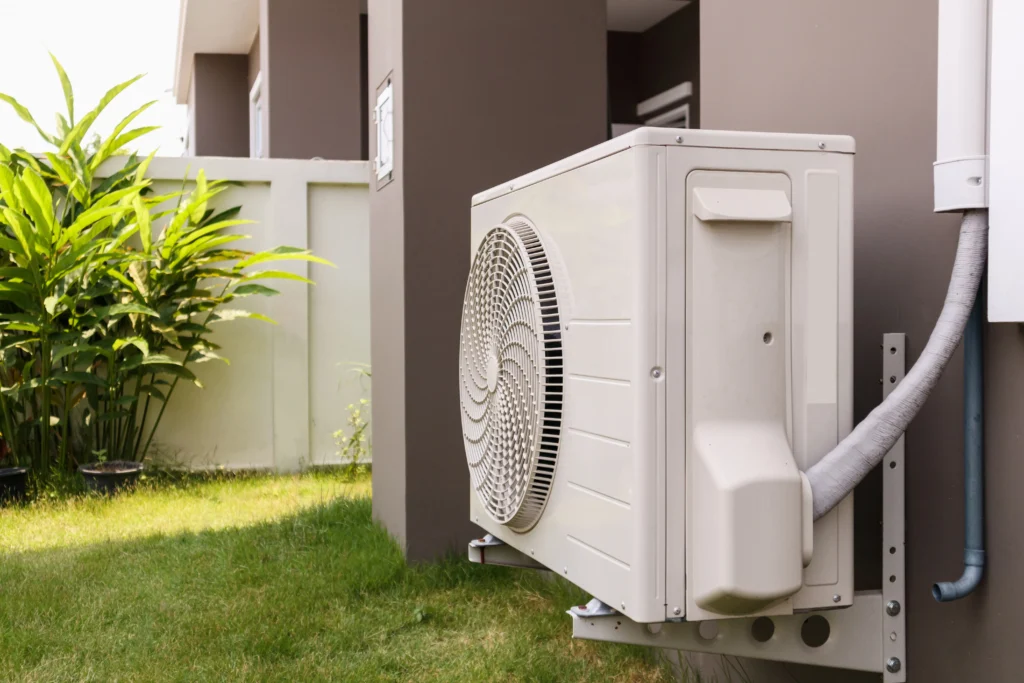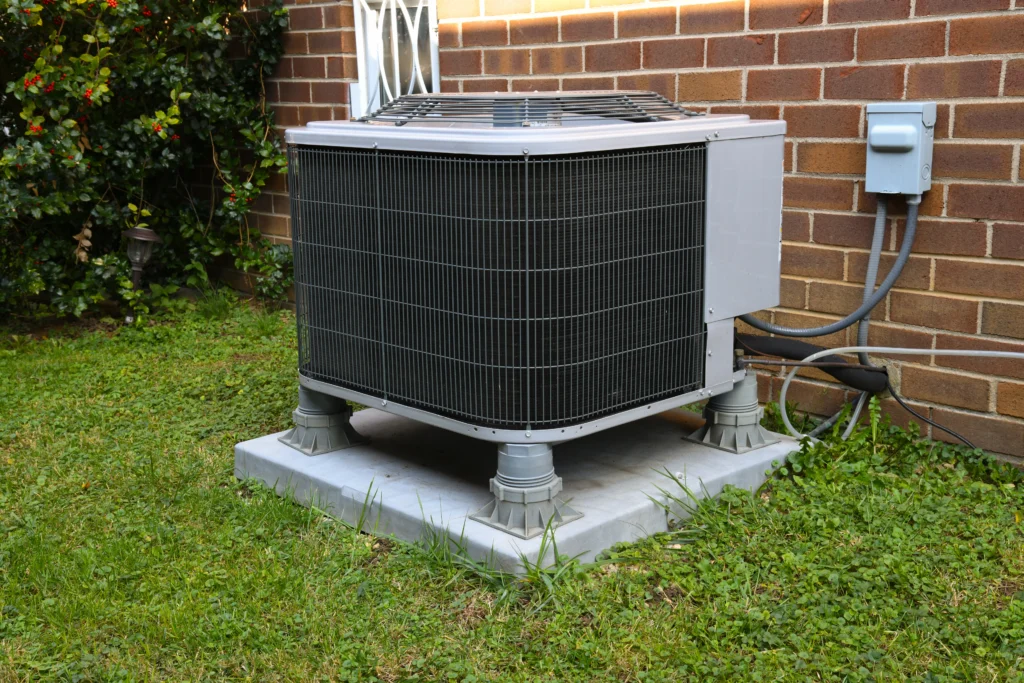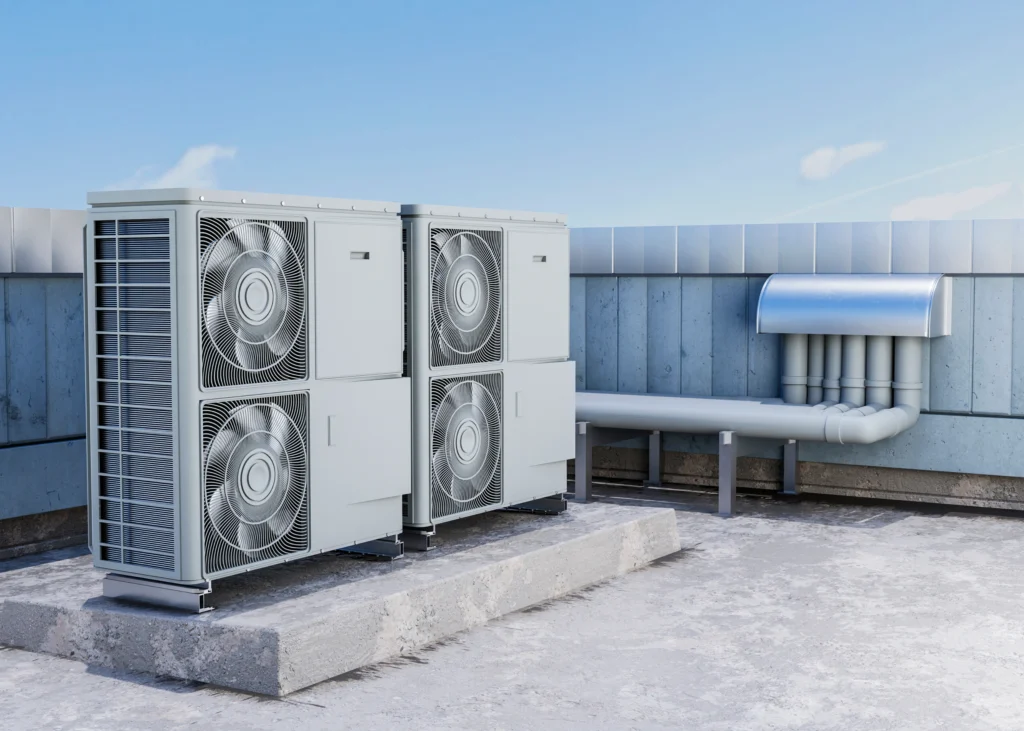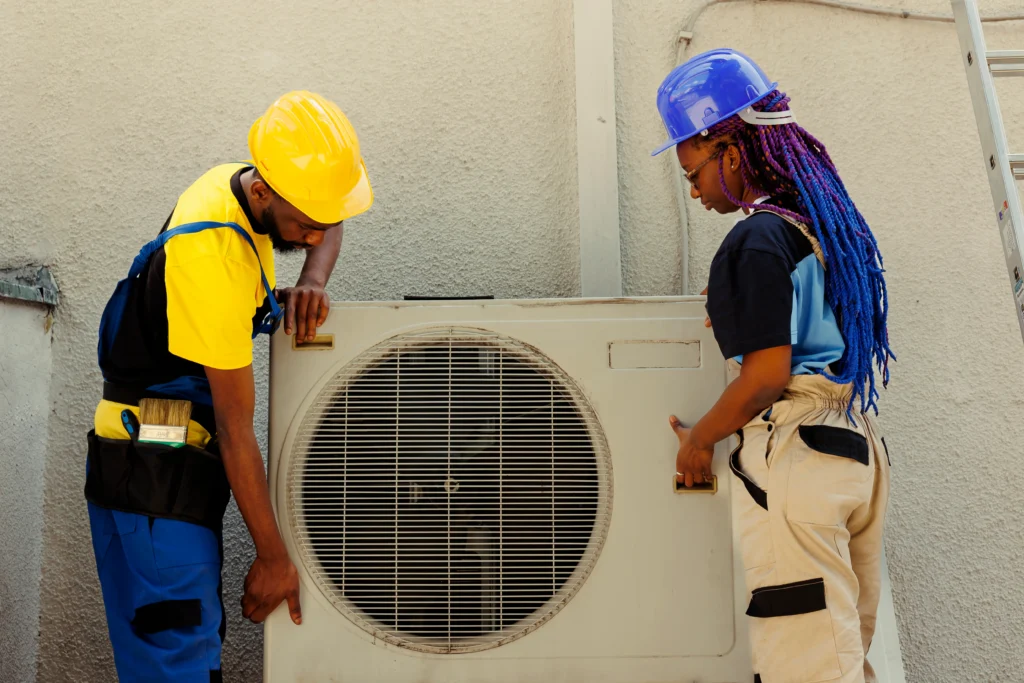HVAC mold inspection is an often overlooked chore that could be a game-changer for indoor air. This quick guide exposes the common slip-ups folks make when checking for mold in their systems.
Have you ever wondered why that musty smell lingers? Dive in as we spill the beans on mistakes and, more importantly, how you can dodge them. Your HVAC‘s health is at stake – let’s keep it mold-free together!
What Is An HVAC Mold Inspection?
Imagine your home as a crime scene, with mold potentially lurking in the shadows. A HVAC mold inspection is the forensic analysis that uncovers the evidence of this invisible culprit. It involves a comprehensive examination of your HVAC system to identify and assess the extent of mold contamination.
Mold inspections aren’t mere check-ups but proactive steps to protect your home and health. Certified professionals carefully examine your heating, ventilation, and air conditioning (HVAC) system, searching every corner for mold growth signs.
The objective is to reveal hidden threats affecting your indoor air quality. Experts use diverse tools and methods in HVAC mold inspection, from air sampling to surface testing, for a comprehensive view of your home’s mold situation. This thorough process ensures no mold spore is overlooked, enabling an accurate diagnosis.
Mold In Your HVAC System

Now, let’s zoom in on the suspenseful subplot – mold in your HVAC system. Picture your HVAC system’s intricate network of air ducts, coils, and vents. While essential for maintaining a comfortable indoor environment, this complex infrastructure can inadvertently become a breeding ground for mold.
The dark, damp conditions within air ducts provide an ideal environment for mold to thrive. If your HVAC system has been neglected, improperly maintained, or exposed to water damage, it becomes a prime target for mold infestation.
The consequences? A compromised air quality can lead to health issues for you and your loved ones. Understanding the signs of mold in your HVAC system becomes crucial to combat this silent invader. From visible mold growth around vents to musty odors when the system is in operation, these indicators are red flags, prompting you to initiate a thorough investigation and potential mold remediation.
In the intricate dance between mold and HVAC systems, vigilance is critical. Regular inspections and prompt actions can turn the tide, ensuring your HVAC system remains a beacon of comfort and not a breeding ground for mold-related concerns.
What Are The Signs Of Mold In Your Air Ducts?
The air ducts in your home silently weave through walls, ceilings, and floors, transporting conditioned air to every room.
However, this intricate network can also become a covert breeding ground for mold. Recognizing the signs of mold in your air ducts is crucial for maintaining a healthy indoor environment.
Visible Mold
Imagine peering into your air ducts only to discover an unwelcome guest – visible mold growth. This is one of the blatant signs that your HVAC system is playing host to mold. Mold can manifest as discolored patches or a slimy coating on the duct surfaces. If you spot these visual cues, it’s a clear indicator that mold has taken residence within your air ducts.
Mold Inside The AC Or Furnace
Venture deeper into the heart of your HVAC system – the AC or furnace. If you find mold lurking within these components, it’s a cause for concern.
Mold inside these crucial elements compromises their efficiency and poses a potential threat to the air quality circulating throughout your home.
Musty Odor When HVAC Is Running
Your nose becomes a detective in this scenario. Picture the distinct, unpleasant aroma of mustiness or moldiness permeating your living space every time your HVAC system kicks into action.
This distinctive odor is a telltale sign that mold is actively circulating in the air.
Allergy Symptoms Or Illness Occurs
Sometimes, the signs of mold aren’t visible to the naked eye, but your body becomes the informant. If you, your family members, or even your pets start experiencing allergy symptoms or unexplained illnesses, it could result from mold spores circulating through the air ducts.
Respiratory issues, skin irritation, and flu-like symptoms may all be red flags signaling a mold presence. In the ongoing drama between your air ducts and mold, staying vigilant to these signs is paramount.
Regular visual and professional inspections can nip mold problems in the bud, ensuring that the air circulating in your home remains a breath of fresh air rather than a potential health hazard.
Ways To Eliminate Mold From HVAC Systems

Discovering mold in your HVAC system doesn’t need to trigger panic. Instead, it initiates a series of strategic moves to eliminate the mold menace and restore your home’s air quality.
Let’s unravel the playbook for tackling mold in your HVAC system.
Find The Mold Source
Begin your quest by identifying the mold’s hiding spot. Is it a leaky duct, poor insulation, or accumulated moisture? Locating the source is like following a trail of breadcrumbs leading to the issue’s heart.
Shine a light on the dark corners of your HVAC system to unveil where the mold is taking root. Once pinpointing the source, it’s time to address the underlying problem. Fix leaks, improve insulation, and eliminate excess moisture. Cutting off the mold’s lifeline disrupts its growth and sets the stage for a mold-free HVAC system.
Hire A Professional To Test For Mold
In the mold battleground, professionals are your seasoned generals. While DIY kits may seem tempting, hiring a certified mold inspector ensures a thorough and accurate assessment.
These experts use specialized tools and techniques to test for mold in every nook and cranny of your HVAC system, leaving no spore unturned.
Professional mold testing goes beyond what’s visible, providing a detailed analysis of air quality and the extent of mold contamination.
This step is essential as it gives a clear plan for the most effective mold remediation strategy customized to your unique situation.
Contact Your Local Mold Removal Services If Needed
Sometimes, the mold insurgency requires reinforcements. Local mold removal services are your frontline soldiers in the battle against HVAC mold.
These specialists bring the expertise and equipment needed to eradicate mold, ensuring a clean slate for your system. If the mold infestation is extensive or if DIY solutions prove insufficient, don’t hesitate to call in the professionals.
Mold removal services have the knowledge and tools to tackle even the most entrenched mold colonies, restoring your HVAC system to its pristine state.
Take Preventative Measures
With the mold threat neutralized, the final act involves fortifying your defenses to prevent a recurrence. Adopting preventative measures is your shield against future mold invasions. Regular HVAC maintenance, adequate ventilation, and moisture control become your allies in this ongoing battle.
Schedule routine inspections to catch potential issues before they escalate. Ensure proper insulation to prevent condensation and address any leaks promptly.
By staying one step ahead, you create an environment inhospitable to mold growth, ensuring the longevity of your HVAC system’s cleanliness.
Cost Of Mold Testing By Type
Understanding the cost of mold testing is like deciphering a menu with various options. Each testing method comes with its price tag, offering different insights into the mold landscape within your home. Let’s explore the costs associated with various mold testing types:
Swab
The swab method is the budget-friendly appetizer on the menu. Swab testing involves collecting surface samples using a swab or a cotton-tipped applicator. This method is beneficial for identifying specific mold types in targeted locations.
The cost-effectiveness of swab testing makes it an attractive choice for those looking to get a quick snapshot of mold presence without breaking the bank.
Air Test
Venture into the main course with air testing, a more comprehensive option. Air testing captures mold spores from the ambient air, providing an overall assessment of mold presence indoors.
This method is crucial for gauging indoor air quality, offering insights into the concentration of mold spores. The slightly higher cost reflects the broader scope and accuracy of air testing.
HVAC
HVAC-specific testing takes center stage for those who want a specialized examination of the heart of the matter. This method zooms in on your heating, ventilation, and air conditioning (HVAC) system, specifically targeting the ducts and components.
While it might come with a higher price, HVAC testing ensures a more focused analysis, identifying mold where it is most likely to impact your home’s air quality.
Stain Testing
Stain testing introduces a different flavor to the menu, involving the application of a solution to surfaces. This method reveals hidden mold through color changes, effectively identifying mold in porous materials.
The cost of stain testing is justified by its ability to pinpoint mold in areas where it might not be immediately visible, offering a comprehensive assessment.
Mold Cultures
Let’s explore mold cultures in laboratories, which involve growing mold samples in a controlled environment. This method helps identify the types of mold present and gives valuable insights into the severity of the infestation.
Although the cost may be higher, mold cultures offer precision and detail, making them a worthwhile investment for those wanting a thorough understanding of their mold situation. In the cost analysis of mold testing, each type plays a unique role in uncovering the mold landscape within your home.
The choice depends on your needs, budget constraints, and the level of detail you seek in your HVAC mold inspection. By understanding the costs associated with each testing method, you can make an informed decision that aligns with your goals for maintaining a healthy indoor environment.
Factors That Affect The Cost Of HVAC Mold Inspection

HVAC Mold inspections are not one-size-fits-all, and the intricacies of your specific situation play a significant role in determining the overall expense. Let’s delve into the factors that can affect the cost of HVAC mold inspection:
Size Of Home
The size of your home serves as the opening act in the cost consideration drama. Larger homes demand a more extensive inspection, involving more square footage and potentially more HVAC components.
The inspection scale directly correlates with the size of your home, impacting the overall cost. Think of it as a grand production with a bigger stage requiring more thorough scrutiny.
Location And Accessibility
As our mold inspection drama unfolds, the setting of your home becomes a pivotal factor. The ease of reaching your HVAC system and possible trouble spots can impact the time and effort needed for the inspection. Accessible areas make the process smoother, while harder-to-reach spots may require more detective work.
The location and accessibility of your home contribute to the overall complexity of the inspection and, consequently, its cost.
Extent Of The Contamination
The plot thickens as we explore the extent of the mold contamination. The inspection becomes more intricate if the mold has infiltrated multiple areas or reached a severe level. Extensive contamination demands a more detailed examination to assess the full scope of the problem. The severity of the infestation directly impacts the time and resources needed for the inspection, influencing the overall cost.
Type Of Mold
In our HVAC mold inspection narrative, different mold types play distinct roles. Some molds are more common and easily identified, while others may require specialized testing methods.
The type of mold present can influence the inspection process and the tools needed, affecting the overall cost. Identifying specific molds adds a layer of complexity, contributing to the variability in inspection expenses.
Geographic Location
As our drama unfolds on the mold inspection stage, the backdrop of your geographic location comes into play. Regional variations in the cost of living and service charges can influence the overall price of mold inspection services.
Consider it as the local flavor impacting the final bill – urban areas may have different price structures than rural locations, contributing to the geographical nuances in cost. In the intricate tapestry of mold inspection costs, these factors combine to create a unique storyline for each home.
Understanding these elements provides clarity, enabling homeowners to navigate the financial landscape of HVAC mold inspections with a comprehensive view. As you embark on your HVAC mold inspection journey, consider these factors as essential characters in the unfolding drama of maintaining a healthy home environment.
Who To Hire For HVAC Mold Inspections

Choosing the right team for your HVAC mold inspection mission is crucial in ensuring a thorough and accurate assessment of your home’s air quality.
Let’s explore the key players you should consider when deciding who to hire for HVAC mold inspections:
- Certified Mold Inspectors: The backbone of your team should be certified mold inspectors. Choose professionals with recognized certifications, like those from organizations such as the International Association of Certified Indoor Air Consultants (IAC2) or the National Organization of Remediators and Mold Inspectors (NORMI). Certification guarantees that inspectors have received proper training and follow industry standards.
- Experience Matters: A seasoned cast can make all the difference. When looking for mold inspectors, focus on those with expertise in HVAC systems. Experienced professionals have the knowledge and a keen eye to spot potential mold hotspots, ensuring a thorough assessment.
- Positive Reviews and Referrals: The audience speaks volumes. Check reviews and seek referrals from friends, family, or neighbors who have undergone HVAC mold inspections. Positive testimonials are a testament to the expertise and reliability of the inspection team. A good reputation in the community is a strong indicator of a trustworthy service.
- Thorough Testing Methods: Your team should bring an arsenal of testing methods. From air sampling to surface testing, a diverse range of techniques ensures a comprehensive examination. Ensure the inspectors have the latest tools and technology to provide accurate results.
- Transparent Communication: A good HVAC mold inspection team communicates openly and transparently. They should be willing to explain the entire process, the methods they’ll use, and the potential outcomes of the inspection. Clear communication fosters trust and ensures that homeowners are well-informed throughout the process.
- Licensed and Insured Professionals: The hvac mold inspection stage is no place for amateurs. Ensure that the team you hire is licensed and carries insurance. Licensing ensures that the inspectors meet state requirements, and insurance protects both you and the inspectors in case of unforeseen incidents during the inspection.
What Causes Mold In Homes?
As we transition to the causative factors of mold growth, let’s uncover the storyline behind the mold invasion:
Mold doesn’t simply materialize; it needs specific conditions to thrive. Here are the primary causes of mold in homes:
- Poor Ventilation: Inadequate ventilation sets the stage for mold growth. Stagnant air allows moisture to accumulate, creating an environment conducive to mold. Ensure proper ventilation in bathrooms, kitchens, and attics to circulate the air.
- High Humidity Levels: Moisture is the protagonist in the mold narrative. High humidity levels, often above 60%, provide the perfect breeding ground for mold spores. Controlling indoor humidity through dehumidifiers and proper ventilation is crucial in preventing mold.
- Water Leaks and Intrusions: Mold’s accomplice is water; leaks are its gateway into your home. Any water intrusion can lead to mold growth, from roof leaks to plumbing issues. Promptly address leaks to thwart mold’s advances.
- Inadequate Insulation: Poorly insulated homes are more susceptible to condensation, especially in extreme temperature variations. Condensation creates a damp environment, inviting mold to thrive. Adequate insulation acts as a shield against mold-friendly conditions.
- Water-Damaged Materials: Materials like drywall, carpeting, and ceiling tiles, when exposed to water damage, become breeding grounds for mold. Promptly address and replace water-damaged materials to prevent the spread of mold.
- Lack of Regular Maintenance: Neglected homes are playgrounds full of mold. Regular maintenance, including inspecting and repairing roofs, gutters, and plumbing, is essential in preventing conditions that favor mold growth.
Warning Signs Of Mold In Homes
Detecting the presence of mold in your home requires a vigilant eye for subtle signs. Here’s a guide to the warning signals that may indicate the unwelcome presence of mold:
- Visible Mold Growth: The most obvious sign is the appearance of visible mold. Keep an eye on walls, ceilings, and corners, especially in damp or poorly ventilated areas. Mold can manifest as discolored patches, fuzzy growth, or slimy coatings.
- Musty Odor: Mold has a distinctive odor – a musty, earthy smell that can permeate the air. If you notice a persistent and unpleasant scent, especially when your HVAC system runs, it could indicate mold lurking nearby.
- Water Stains: Stains on walls or ceilings can be a precursor to mold growth. Water stains are often a result of leaks or water damage, creating an environment conducive to mold. Investigate and address these stains promptly to prevent mold colonization.
- Peeling Paint or Wallpaper: Mold can disrupt the adhesion of paint or wallpaper to surfaces. If you observe peeling or bubbling, especially in areas prone to moisture, it may be a sign of underlying mold growth.
- Warped Walls or Bulging: Moisture absorption can cause materials like drywall to warp or bulge. Check for irregularities in walls and ceilings, as these physical changes may indicate the presence of hidden mold.
- Allergic Reactions: Mold can trigger allergic reactions, including sneezing, coughing, itching, or watery eyes. If you or your family members experience unexplained allergy symptoms at home, it could be a sign of mold spores circulating in the air.
- Respiratory Issues: Prolonged mold exposure can lead to respiratory problems, especially for individuals with asthma or other respiratory conditions. If you notice increased respiratory issues without an apparent cause, mold may be a contributing factor.
- Unexplained Illness: Mold exposure can sometimes lead to flu-like symptoms, fatigue, or headaches. If you consistently experience these symptoms at home, it’s worth considering a HVAC mold inspection.
Mold In The Air Duct?
As we delve into the specific setting of air ducts, let’s uncover the signs that may point to the presence of mold within this vital component of your HVAC system:
- Musty or Mildew-Like Odor: An unusual, persistent smell emanating from the vents when your HVAC system runs can be a red flag. This odor often indicates the presence of mold within the air ducts, circulating spores throughout your home.
- Black Dust Around the Air Handler or Vents: Black dust around the air handler, vents, or registers might signal the presence of black mold, scientifically known as Stachybotrys chartarum. This mold can produce mycotoxins, posing potential health risks.
Detecting mold in air ducts may require professional inspection, especially since the signs can be subtle. If you notice any of these signs, it’s wise to seek help from certified professionals for a detailed inspection of your HVAC system. Regular maintenance and quick action can keep your air ducts free from mold spores, ensuring they continue to distribute clean and healthy air.
Air Duct Mold Treatment
Discovering mold in your air ducts can be disconcerting, but effective treatment is crucial to restore your HVAC system to a mold-free state.
Let’s unravel the strategies for air duct mold treatment:
- Professional Inspection: Begin with a professional inspection of your air ducts. Certified mold inspectors will assess the extent of the mold infestation and identify the specific type of mold present. This information is pivotal in tailoring an appropriate treatment plan.
- Identification of the Source: Before starting the treatment, it’s crucial to find and fix the source of moisture or humidity that allowed mold to grow in the air ducts. Whether it’s a leak, insufficient insulation, or poor ventilation, addressing the root cause is vital for long-term success.
- Isolation of Contaminated Areas: In severe cases, experts might isolate the contaminated sections in the air ducts to stop the spread of mold spores during treatment. This containment step ensures the remediation process is effective and reduces the risk of cross-contamination.
- HEPA Vacuuming: High-efficiency particulate air (HEPA) vacuuming removes loose mold spores and debris from the air duct surfaces. This step is crucial for preparing the ducts for subsequent treatments and preventing the re-circulation of mold during cleaning.
- Antimicrobial Treatment: Applying antimicrobial agents is critical to air duct mold treatment. These agents help to kill and inhibit the growth of mold and other microorganisms. The choice of antimicrobial treatment may vary based on the type of mold identified during inspection.
- Biocide Application: Biocide chemicals, designed to kill mold, can be applied within the air ducts. This precise method ensures effective mold elimination without causing harm to the HVAC system or the people in the space.
- Sealant Application: In cases where mold has caused damage to duct insulation or if the ducts are composed of porous materials, applying a sealant can help encapsulate and seal the affected areas. This step prevents the release of mold spores into the air and reinforces the structural integrity of the ducts.
- HEPA Air Filtration: Once you’ve removed mold physically, installing HEPA air filters in your HVAC system can capture any remaining mold spores and stop them from spreading. HEPA filters are excellent at trapping tiny particles, ensuring the air in your home stays clean.
- Post-Treatment Inspection: Once the treatment is complete, a post-treatment inspection is conducted to ensure the success of the remediation efforts. This involves retesting air quality and inspecting the air ducts to verify that mold levels have been controlled.
Remember, air duct mold treatment is a complex process that requires professional expertise. DIY attempts may lead to complete removal; proper handling can exacerbate the problem. Enlisting the services of certified mold remediation professionals ensures a thorough and effective treatment tailored to your specific situation.
What Is Black Mold?
In the mold spectrum, black mold takes center stage as a term that often evokes concern and fear. Let’s demystify black mold and understand its characteristics:
Critical Characteristics of Black Mold:
- Color: Stachybotrys chartarum is often black or dark green. However, it’s essential to note that not all black molds are of the Stachybotrys genus.
- Texture: Black mold can have a slimy or wet appearance when wet and a powdery or dry texture when it dries. This distinguishes it from other molds.
- Preferred Habitat: Black mold thrives in areas with prolonged water exposure or high humidity. It commonly grows on cellulose-rich materials like wood, paper, and drywall.
- Mycotoxins: The potential production of mycotoxins by black mold is a cause for concern. Mycotoxins can harm human health, leading to respiratory issues and other health concerns.
Health Concerns:
Black mold can lead to health problems, especially for people with respiratory issues, allergies, or weakened immune systems. Symptoms may include coughing, sneezing, skin irritation, and breathing difficulties.
Prevention and Remediation:
Preventing black mold involves controlling moisture and promptly addressing water damage. Adequate ventilation, regular inspections, and swift response to leaks or floods are vital preventive measures.
If black mold is identified in your home, professional remediation is recommended. Certified mold remediation specialists have the expertise and equipment to safely and effectively remove black mold, minimizing health risks and preventing its recurrence.
Knowing about black mold and its characteristics gives homeowners the power to take proactive steps to prevent its growth and promptly address potential issues. Quick action and professional help are crucial when dealing with black mold to ensure the safety and well-being of occupants.
Signs Of Mold In Air Ducts
As we explore the clandestine world of air ducts, sure signs may point to the elusive presence of mold. Detecting these indicators early is critical to maintaining a healthy indoor environment. Let’s unravel the signs of mold in air ducts:
Musty Or Mildew-Like Odor
Imagine entering your home and being greeted by an unpleasant, musty aroma. This distinctive scent often indicates the presence of mold in your air ducts.
Mold releases volatile organic compounds (VOCs), contributing to the characteristic musty or mildew-like odor.
If this odor becomes more pronounced when your HVAC system runs, it’s a red flag that mold may lurk within the ductwork.
Black Dust Around the Air Handler or Vents
Picture a subtle layer of black dust accumulating around the air handler or vents. This seemingly innocuous presence may be a visual manifestation of mold.
Black dust is often associated with certain mold types, including Stachybotrys chartarum (black mold), which can thrive in the damp environment of air ducts.
If you notice this peculiar dust, it’s a cue to investigate further for potential mold growth.
In the covert dance between mold and air ducts, these signs serve as the choreography, guiding homeowners to take action.
If you encounter a musty odor or detect black dust, it’s time to consider a thorough inspection of your air ducts.
Swift detection and professional intervention can prevent mold from turning your ductwork into an unwelcome habitat and ensure that the air circulating in your home remains pristine.
FAQ More About HVAC Mold Inspection
How Do You Check for Mold in the HVAC?
Professionals use various testing methods, including air testing, swab testing, and HVAC-specific inspections, to check for mold in HVAC systems.
How Common Is Mold in HVAC?
Mold in HVAC systems is relatively common, especially in poorly maintained or neglected systems. Regular inspections and maintenance can prevent mold growth.
Can Mold Be Cleaned Out of the HVAC?
Yes, mold in HVAC systems can be cleaned out. Professional mold remediation services can eliminate mold, ensuring your HVAC system operates cleanly and healthily.
What Does Mold in HVAC Ducts Look Like?
Mold in HVAC ducts can appear as discolored patches, slimy coatings, or even black dust. Professional inspection is crucial for accurate identification.
What Are Signs of Mold Sickness?
Signs of mold sickness include respiratory issues, allergies, skin irritation, and flu-like symptoms. If you suspect mold is causing health problems, consult a healthcare professional.
What Kills Mold in HVAC Ducts?
Professional mold remediation services use specialized cleaning agents and techniques to effectively kill and remove mold from HVAC ducts.
What Is The Importance Of HVAC Mold Inspection?
HVAC mold inspection is crucial for detecting and addressing mold growth within your heating, ventilation, and air conditioning system. Regular inspections can prevent mold from spreading and ensure your indoor air quality remains healthy.
How Does HVAC Inspection For Mold Differ From General Maintenance?
While general maintenance focuses on the functionality of your HVAC system, HVAC mold inspection specifically targets the presence of mold. This involves thorough examination and testing to identify any mold growth and determine appropriate remediation steps.
Can Air Purifiers For Mold Effectively Improve Indoor Air Quality?
Yes, air purifiers designed to target mold can significantly improve indoor air quality by capturing mold spores and other airborne contaminants. However, it’s essential to choose the right type of air purifier and maintain it regularly for optimal performance.
How Do I Get Rid Of Mold In The Air Within My Home?
Removing mold from the air requires a combination of strategies, including proper ventilation, humidity control, and the use of air purifiers for mold. Additionally, addressing any sources of moisture and conducting regular HVAC mold inspections are essential steps in preventing mold growth.
What Are The Best Air Cleaners For Mold In HVAC Systems?
When selecting an air cleaner for mold in your HVAC system, look for high-efficiency particulate air (HEPA) filters or air purifiers specifically designed to target mold spores. These devices can effectively capture and remove mold particles, improving your indoor air quality.
Conclusion
prioritizing HVAC mold inspection is crucial for maintaining a safe and healthy indoor environment. By investing in air purifiers for mold and employing effective removal methods, you can ensure cleaner air and safeguard your family’s well-being. Remember to schedule regular inspections and take proactive measures to mitigate mold growth in your HVAC system. With the right approach, you can breathe easier and enjoy a mold-free home.
